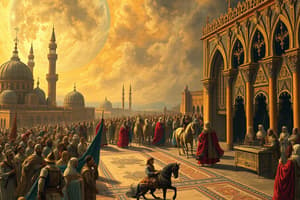Podcast
Questions and Answers
What was a significant outcome of the Second Crusade?
What was a significant outcome of the Second Crusade?
- Failure to achieve objectives leading to decline of Crusader power (correct)
- Establishment of Crusader states
- Strengthening of the Byzantine Empire
- Successful recapture of Jerusalem
The Third Crusade successfully recaptured Jerusalem.
The Third Crusade successfully recaptured Jerusalem.
False (B)
Name one cultural exchange that resulted from the Crusades.
Name one cultural exchange that resulted from the Crusades.
Transfer of knowledge in science, medicine, and philosophy
The _____ of Acre in 1291 marked the end of Christian rule in the Holy Land.
The _____ of Acre in 1291 marked the end of Christian rule in the Holy Land.
Match the key events of the Crusades with their descriptions:
Match the key events of the Crusades with their descriptions:
Flashcards are hidden until you start studying
Study Notes
High Middle Ages
Crusades
- Series of religious wars (1096-1291) initiated by European Christians to reclaim the Holy Land from Muslim control.
- Key Crusades:
- First Crusade (1096-1099): Successful in capturing Jerusalem; established Crusader states.
- Second Crusade (1147-1149): Failed to achieve objectives; marked decline of Crusader power.
- Third Crusade (1189-1192): Led by Richard the Lionheart; failed to recapture Jerusalem but negotiated access for pilgrims.
- Fourth Crusade (1202-1204): Diverted to Constantinople; resulted in the sack of the city and weakened Byzantine Empire.
- Motivations: Religious fervor, desire for land, wealth, and adventure.
Disasters and Victories
- Disasters:
- Fall of Acre (1291): Marked the end of Christian rule in the Holy Land.
- Massacres and defeats: Losses at Hattin (1187) and other battles diminished Crusader morale and strength.
- Victories:
- Initial successes in capturing cities like Edessa and Antioch.
- Establishment of fortified settlements (e.g., Jerusalem, Tripoli) that acted as bases for further expeditions.
Long Term Consequences
- Cultural Exchange: Increased contact between Christians and Muslims led to the transfer of knowledge, including science, medicine, and philosophy.
- Economic Impact: Growth of trade routes; increased wealth for Italian city-states (e.g., Venice, Genoa).
- Political Changes: Rise of centralized monarchies in Europe; decline of feudalism as nobles participated in Crusades.
- Religious Tensions: Deepened divisions between Christianity and Islam; lasting hostility influenced future relations.
- Legacy of Military Orders: Establishment of groups like the Knights Templar and the Hospitallers, which would play roles in later conflicts.
Crusades
- Series of religious wars between 1096 and 1291, launched by European Christians aiming to reclaim the Holy Land from Muslim control.
- First Crusade (1096-1099): Successfully captured Jerusalem, leading to the establishment of several Crusader states.
- Second Crusade (1147-1149): Failed mission; marked significant decline in Crusader influence and power.
- Third Crusade (1189-1192): Notable leader Richard the Lionheart aimed to retake Jerusalem; while unsuccessful, it resulted in a negotiated agreement allowing pilgrim access to the city.
- Fourth Crusade (1202-1204): Unexpectedly diverted to Constantinople, leading to the city's sack and contributing to the weakening of the Byzantine Empire.
- Motivations for the Crusades included religious zeal, territorial expansion, seeking wealth, and the allure of adventure.
Disasters and Victories
- Fall of Acre (1291): Significant defeat that ended Christian rule in the Holy Land.
- Major defeats, especially at the Battle of Hattin (1187), severely impacted Crusader morale and military strength.
- Initial Crusade efforts led to several victories, including the seizure of cities like Edessa and Antioch.
- Establishment of fortified settlements, such as Jerusalem and Tripoli, served as strategic bases for future Crusader expeditions.
Long Term Consequences
- Cultural Exchange: Increased interaction between Christians and Muslims facilitated the transfer of knowledge in fields such as science, medicine, and philosophy.
- Economic Impact: The Crusades spurred growth of trade routes, resulting in economic prosperity for Italian city-states, notably Venice and Genoa.
- Political Changes: The events of the Crusades contributed to the rise of centralized monarchies in Europe and a decline in feudalism, as noble participation in the Crusades altered power dynamics.
- Religious Tensions: The Crusades intensified hostilities between Christianity and Islam, establishing lasting divisions that shaped future relations.
- Legacy of Military Orders: Groups like the Knights Templar and the Hospitallers emerged from the Crusades, playing significant roles in subsequent military conflicts.
Studying That Suits You
Use AI to generate personalized quizzes and flashcards to suit your learning preferences.




